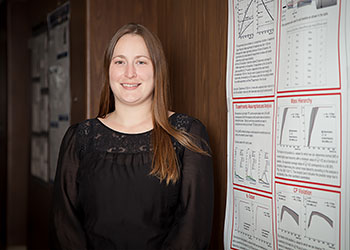Honors Her Contributions to the Field of Neutrino Science
Rising star. Outstanding physicist. Leader.
These descriptions crop up, again and again, in letters recommending Lisa Whitehead, assistant professor of physics, as this year’s recipient of the College of Natural Sciences and Mathematics (NSM) Junior Faculty Award for Excellence in Research. For this honor, she was presented with a plaque and an award of $5000.

Whitehead, an experimental particle physicist, was the recipient of the 2015 NSM
Junior Faculty Research Award.This annual award, introduced in 2015, recognizes the exceptional research contributions
of faculty at the assistant professor level. One faculty member from each department
can be nominated by the head of the department, who writes a letter in support of
the nomination. In addition, three respected individuals from outside the university
and in the nominee’s field are asked to provide letters of recommendation describing
the candidate’s research contributions.
Whitehead, who joined the University of Houston as an assistant professor in 2011, is an experimental particle physicist studying the properties of neutrinos, which are subatomic particles that have no charge and a mass that is, at most, a millionth that of an electron.
“The most challenging aspect of neutrino research is detecting them,” Whitehead said. “We can produce very intense sources of neutrinos on Earth, using accelerators or nuclear reactors, but we can only detect a small fraction of these neutrinos.” These properties make neutrinos extraordinarily difficult to study.
Whitehead, who has spent her entire research career studying neutrinos, has been involved in some of the major initiatives that moved the field forward. One of Whitehead’s notable contributions is her involvement with the Daya Bay Reactor Neutrino Experiment, which was named one of the top 10 science breakthroughs of 2012 by Science magazine.
In the Daya Bay experiment, Whitehead and her collaborators identified the last unknown parameter, called theta-one-three, for describing how neutrinos morph into each other.
“Whitehead performed many of the early estimates of the sensitivity of the Daya Bay experiment and was a member of the team that released the first analysis results,” noted a recommender. Whitehead’s role in the Daya Bay experiment was recognized with the highly competitive Department of Energy Office of Science Early Career Research Award.
In addition to her involvement with the Daya Bay experiment, Whitehead is also a leader in the Deep Underground Neutrino Experiment (DUNE), formerly called the Long Baseline Neutrino Experiment (LBNE), which is an accelerator-based neutrino experiment that will begin collecting data within the next ten years.
One of her letters of recommendation stated “I expect Whitehead to be at the forefront of LBNE (DUNE) leadership as it collects data to unravel the mysteries of the matter/antimatter asymmetry of the universe in the coming decade.”
For every particle of matter there is its opposite counterpart, called an antiparticle. During the Big Bang, physicists think that particles and antiparticles were produced in pairs. However, today, we only observe only matter. How this happened is still a mystery.
“Everything we see in the universe is made of matter (not antimatter), and it's not clear how the imbalance came about,” Whitehead said. “If we discover matter-antimatter asymmetries in the behavior of neutrinos, it might one day give us a clue as to how the matter-antimatter asymmetry in the universe developed.”
- Rachel Fairbank, College of Natural Sciences and Mathematics